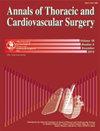Concomitant Mitral Regurgitation in Patients Undergoing Surgical Aortic Valve Replacement for Aortic Stenosis: A Systematic Review.
IF 1.3
4区 医学
Q4 CARDIAC & CARDIOVASCULAR SYSTEMS
Annals of Thoracic and Cardiovascular Surgery
Pub Date : 2022-06-20
Epub Date: 2022-02-09
DOI:10.5761/atcs.oa.21-00170
引用次数: 1
Abstract
Background: Concomitant mitral regurgitation (MR) is frequently seen in patients undergoing surgical aortic valve replacement (AVR) for severe aortic stenosis (AS). When the severity of MR is moderate or less, the decision to undertake simultaneous mitral valve intervention can be challenging. Methods: A systematic search of Medline, PubMed (NCBI), Embase and Cochrane Library was conducted to qualitatively assess the current evidence for concomitant mitral valve intervention for MR in patients with AS undergoing AVR. The primary outcome for this systematic review was the postoperative change in the severity of MR and other outcomes of interest included factors that predict improvement or persistence of MR and long-term impacts of residual MR. Results: A total of 17 studies were included. The percentage of patients demonstrating improvement in MR severity following AVR ranged from 17.2% to 72%; the studies that exclusively included patients with moderate functional MR and reported longer term echocardiographic follow-up of greater than 12 months demonstrated an improvement in MR severity of 45% to 72%. Conclusion: This systematic review demonstrates that a proportion of patients can exhibit an improvement in MR following isolated surgical AVR, but whether this confers any long-term morbidity and mortality benefit remains unclear.

主动脉瓣狭窄手术置换术患者并发二尖瓣返流:一项系统综述。
背景:合并二尖瓣反流(MR)在严重主动脉瓣狭窄(AS)的手术主动脉瓣置换术(AVR)患者中很常见。当MR的严重程度为中度或更轻时,同时进行二尖瓣介入治疗的决定可能具有挑战性。方法:系统检索Medline、PubMed (NCBI)、Embase和Cochrane图书馆,定性评估AS行AVR患者合并二尖瓣干预MR的现有证据。本系统评价的主要结果是术后MR严重程度的变化,其他感兴趣的结果包括预测MR改善或持续以及残余MR的长期影响的因素。结果:共纳入17项研究。AVR后MR严重程度改善的患者比例从17.2%到72%不等;专门纳入中度功能性MR患者的研究,并报告了超过12个月的长期超声心动图随访,结果显示MR严重程度改善了45%至72%。结论:本系统综述表明,部分患者在孤立性手术AVR后MR改善,但这是否会带来任何长期发病率和死亡率的益处尚不清楚。
本文章由计算机程序翻译,如有差异,请以英文原文为准。
求助全文
约1分钟内获得全文
求助全文
来源期刊

Annals of Thoracic and Cardiovascular Surgery
CARDIAC & CARDIOVASCULAR SYSTEMS-SURGERY
CiteScore
2.80
自引率
0.00%
发文量
56
审稿时长
4-8 weeks
期刊介绍:
Information not localized
 求助内容:
求助内容: 应助结果提醒方式:
应助结果提醒方式:


